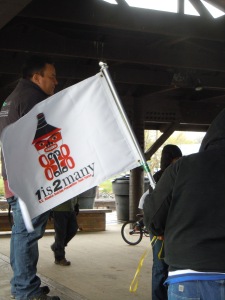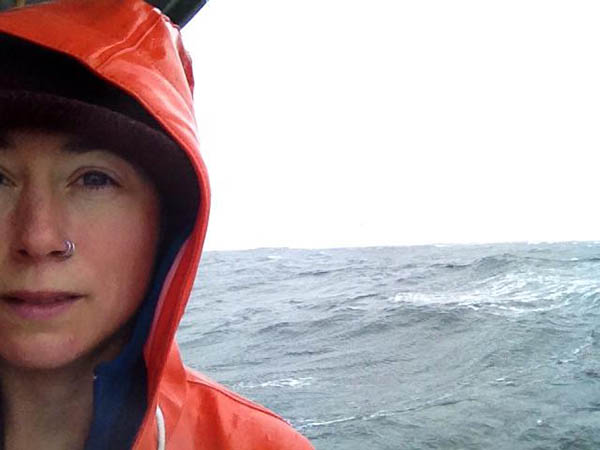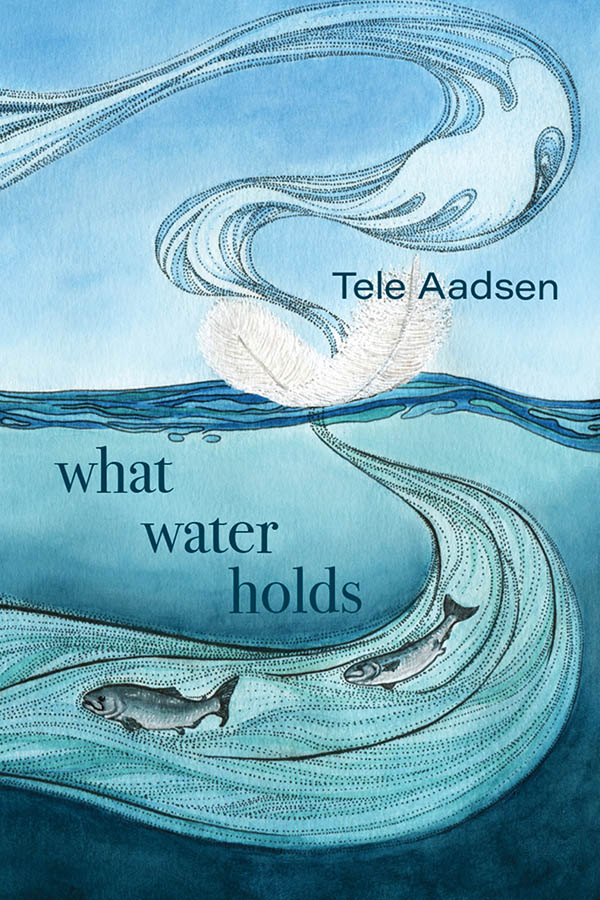No halibut on deck here… Consistent storms have tethered us to the dock for two weeks, waiting out weather like 45 knot winds and 22-foot seas. We take it for what it is – what else can you do? – but watching steady gray sheets pouring down the cabin windows gets old.
So I go for a walk.
Southeast Alaska’s second annual Walk for Life is scheduled to gather at Crescent Harbor at 12:30. Scoping the scene from across the street, I see three people huddled against snarling wind and icy shards of rain. Oh, man… But taking a public stand against suicide seems especially necessary on such a grim day. I yank my hood up and head over.
Others feel similar urgency. Over the next half-hour, about 50 people fill the harbor shelter: cane-bearing elders, bundled children, young couples. Organizers from the SouthEast Alaska Regional Health Consortium (SEARHC) hand out T‑shirts emblazoned with The Watchman, a symbol of courage designed by Tlingit artist Robert Hoffmann.
With everyone decked out and ready to march, SEARHC Suicide Prevention Program Manager Wilbur Brown calls for our attention. “If you’ve been around Alaska at all,” he begins, “you know there’s a lot of suicides here.”
A lot of suicides… Statewide, Alaska doubles the national average, while rates in remote Arctic villages are up to seven times higher. From our mountains, salmon, and bears, to our chemical dependency, domestic violence, and despair, we have it all bigger, badder.
Wilbur explains that Walk for Life is a response to those staggering losses. Initiated in Kotzebue, the first walk took place in 2009. (150 people participated in nearby Ambler – almost half of the Kobuk River village’s population.) In 2011, Tessa Baldwin, a Kotzebue teenager, inspired Southeast Alaska to join. One year later, the prevention effort has been embraced statewide. “People are walking for life all over Southeast today – people are walking in Angoon, Hoonah, Kake, Klawock, everywhere. We’re walking to celebrate life and say no to suicide.”
So we walk. Led by a police escort, we march through an intersection (one of Sitka’s two stoplights) and down the main drag, winding around Saint Michael’s Russian Orthodox Church and turning to parallel the channel. We hold up traffic. One driver leans out her window with a smile. “What is this?” Her smile washes away with the answer.
We file into the Sheetka Kwaan Naa Kahidi house, where Wilbur opens the ceremony. He hopes that through events like these, we might lessen the taboo of talking about suicide. “Alaska’s highest suicide rates are among young men. And what do we teach our young men? We teach them not to talk, not to feel, not to communicate. We want to show them there’s another way.”
One of those ways may be through cultural revitalization. For the next several hours, Naa Kahidi pulses with tradition’s heartbeat. Accompanied by a single drum, four Ravens stand at the stage edge, voices raised in a sorrow song shared by Hoonah’s Sea Pigeon clan. A group of Eagles respond, keening loss that pierces through the rafters, through time and place, through language.
Nodding with the beat, I glance at the ink on my left forearm. Part of me for 13 years, this tattoo usually demands about as much conscious consideration as a pinky toe, but in this setting, the Viktor Frankl quote seems to glow. That which seeks to give light must endure burning.
I remember burning… Sitting mute in the psychiatrist’s office, consumed by blistering loneliness, resolute. (Nine years old, I’d already aced my family’s lessons on silence.) Another lifetime trapped within that flame. Alliances with alcohol, friends whose angst mirrored my own. Skin carved like pie crust to relieve the steam within.
I remember light… Blinking against newly broken dawn as I staggered into my tribe. People who offered hope, connection, the thrill of community. We strolled bold amongst dragons, confident we’d pass through without a scorch.
It’s been seven years since I was a practicing social worker. I exchanged the path of tending lives for one of taking life, hunting fish half the year, yet still I find myself whispering the names of those we lost. The young man who committed suicide by cop. The young woman who hung herself in jail. In a hospital. In a garage. With an overdose. With a shotgun. After being kicked out of the family for being gay. After seeming to have made it, whatever “made it” meant. Those we lost, and those we might have. Those whose despair feasted like parasites, those who crooked their fingers to death and silently screamed please.
I remember the hiss of light guttering out, echoed by the mechanical slurp of a stomach pump. By then I’d learned that if I sat very quietly – as still as the dead – and wiped my expression mountain stream clean, the ER personnel would let me stay with the kid I’d brought in. Studying the steady extraction of a young woman’s stomach contents, grainy residue awash in waves of Pepsi Blue, I wondered how I’d ever dared imagine I’d sidestep burn-out.
Back in Naa Kahidi, six drummers gather around the Hashagoon drum, centered on the main floor. “We’re going to do a song to honor those who’ve passed away from suicide,” one explains. “Please remove any head coverings and stand if you’re able to do so. You’re welcome to join us to dance if you’d like.”
A circle forms around the drummers. I study the pairs of Xtra Tufs and sneakers, all moving with differing degrees of certainty and grace. Shuffle, toe, step, toe, knees flex, shuffle. As the faces of my dead and might-have-beens shimmer against the dancers’ feet, it’s easy to meditate on the losses binding us.
But a child careens through the room. Arms outstretched and a grin wide enough to swallow the sun, he runs against the stream on socked feet. He’s shirtless, a clan robe around his shoulders, clasped with five pearl buttons spanning his narrow chest. The robe is a stunning piece of regalia, a red and black link to his history, but today it’s a cape streaming behind him and he’s Superman. He runs faster – he flies – the embodiment of joy, curiosity, and light. He shoves grief aside, inflates us all with his buoyancy.
I leave Naa Kahidi wanting to believe that little boy will keep flying. That the dragons who reduced so many other heroes’ capes to charred ash will leave him be. I hope he grows up knowing how to ask for help, that the only shame is in silence. I hope he learns there’s another way.
If you or someone you know is feeling suicidal, please talk to someone. Here in Southeast, contact SEARHC’s Helpline at 1 – 877-294‑0074. Nationwide, call the National Suicide Prevention Lifeline at 1.800.784.2433. Be well.





Moving post, Tele. Thank you.
Thanks, buddy. Now, what was it you and Pam suggested about some lighter posts featuring my bizarre writing spaces? 🙂
Thank you, Tele, for writing this, and for posting. Very affecting and, unfortunately, very timely…You take good care.
Oh, Kathryn… I’m so sorry that the topic resonates. My best wishes to you and yours.
Beautiful, Tele. Thank you for bringing us light. Enduring the ring of fire, dancing in it.
Thank you, Pierr. I hope that you’ve had a wonderful birthday month, enjoying lots of pre-summer light with your grandson!
So beautiful and sad, Tele. There has to be an Alaska literary magazine to which you could submit this. So beautiful.
Thanks for that, Julie. I’ve been truly negligent about submitting work thus far, but am starting to gather some ideas. Thanks for the encouragement and role modeling!
Oh Tele … nine years old … very moving. Good for all those who joined in the walk and everyone who works to bring hope to those in despair.
I’m certain that you’ve been one of those who brings hope, Patricia. Thanks for the value you place on honoring people’s stories, friend.
terribly beautiful. thank you.
Most welcome, grainsifter. Thanks for stopping by — hope May’s treated you well.
Thank you for posting this Tele . It is unfortunate how at times things happen the way they do. Young lives ended short is always something hard to deal with. I only wish that when someone feels so down and out that they feel they must do something to themselves there would be someone there to help them through whatever it is they are having trouble with . Help them to learn that there life is worth something and they can overcome anything. Thank you again .
Well said, Tom, and many thanks for your visit. How’s the dock-walking treating you? I’ve seen a few new faces in the harbor and have wondered if you’re among them. Best wishes on your search.
Very heartfelt and powerful. Thanks for this! What a gift wind and rain can be.
Ha! That’s the right attitude, Pat, and so very true — we may not have gotten any fishing done, but I’m grateful for any opportunity to become more a part of the community. Hope that Veronica’s feeling good!
This is an elegant piece, in true Tele style, painfully sweet. Thank you.
Thanks, Steffany. How did your reading go? Did you enjoy yourself? I thought of you all that evening (through a haze of black cod slime/blood) — so very proud of you!
Beautiful piece about a truly tragic topic. Hugs.
Hugs right back to you and Lola!
As usual, your words move my soul. Thank you for writing this and sharing your perspective about this important topic.
Thanks so much for dropping by, Dawn. I’ve felt the same way about your tornado posts — thank you for reminding us of the real people continuing to experience loss and recovery, long after it’s no longer the tragedy of the moment.
Having met you and primarily known you in those Social Work years I don’t know how you thought you would avoid burnout either and I am glad you have found some sense of balance in your life and are shining the light on those hard parts. I honestly don’t know how I have managed so long but I do know that the connection to nature is key for me as well. Maaahaaa!
Thanks, Adrienne… As one of my early mentors, your kind words mean a lot. I’ve been enjoying following the balance and joy that you’ve brought into your own experience, too. What could be better than head-butting, loving goats? (Hugs to you, my friend!)
Thought provoking Tele, perhaps that work that you so willingly gave yourself too is also a stage, we give while we have the continual energy to do so, and then it changes and evolves and requires another direction, it seems to me you are continuing to do similar work, but in a different way, your words certainly make a difference to people’s lives and your way of life nurtures it.
You’re very generous, Claire. I agree with you that we’re all capable of making positive contributions and our methods of doing so are as different as we all are. Many thanks for your thoughtful comment.
Difficult subject to tackle. Thank you for your courage.
Thanks, Graham. The little boy zooming around definitely helped me leave the experience with a smile I wouldn’t have otherwise had.